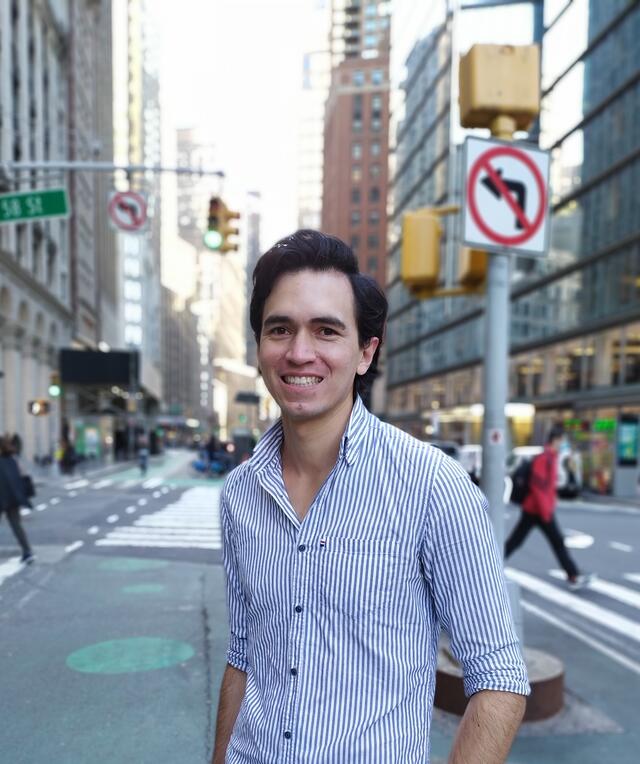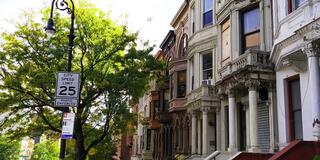
And Yet We Travel

By Ricardo García Coyne MPA-DP ’21
Colorful clothes hang out of the windows to dry. A short, kindly looking woman in a white-and-pink dress is chatting with her neighbor at the doorstep. Th e narrow alleyway of the lilong* is almost entirely blocked by parked cars, but my Shanghainese guide manages to zigzag his way around the obstacles. I can see the low-rise, century-old buildings that have survived the city’s urban redevelopment. The crowded, labyrinthine streets that neighbors refuse to abandon. My guide walks in silence, focused on capturing the uneventful naturality of a Tuesday afternoon. My espresso maker starts to hiss. I get up from the computer and refill my mug. A cool breeze and Latin rhythms flood my Washington Heights studio apartment through the open window.

“We old folk belong on the ground floor,” explains a longtime lilong resident in a brown leather jacket. “We have good relations with our neighbors and offer a helping hand to each other if anything happens. People are not related in the high-rises. It is not convenient for us old people.” I sip another cup of coffee while I listen to this interview from seven years ago. Dozens of tabs populate my upper screen: photos, videos, interviews with residents, essays from local writers, notes from a call with a Shanghainese colleague—an eff ort to look underneath the statistics, beyond the traditional voices most readily available for people researching from far away.
February 2021 (New York City). Travel is restricted. Having defined the next steps of our research on Timor-Leste’s agricultural policies, I log off the NYC-Australia Zoom call. Time to focus on my other internship, drafting the interview protocol that we will use next week when we talk to an investment approval officer in Tanzania. My research teams, like the SIPA community at large, are scattered around the world. We are an international community that exceeds any and all boundaries, and no pandemic can put a halt to our global disposition. We resist. We adapt. We feel together. We thrive together. We come back stronger. We are pushed to come up with different research and management tools, pushed to work around the issues that simply cannot be approximated remotely. Our drive to collaborate overcomes all barriers.
May 2018 (Mexico City). Travel is not restricted. After hours on the highway, I arrive in Pachuca, Mexico, and go straight to the Land Registry Office to meet with the general director. Our one-hour meeting is followed by interviews with several government officials. We then dive into their archives, analyzing building and land-use permits in a dusty and poorly lit basement. At 6 p.m. we go to the hotel to debrief, grab a bite at the hotel’s restaurant, and head to our rooms to prepare the slide deck for the client. The next two days follow the same pattern. The trip is over, and we head back to Mexico City. I spent three days in Pachuca and yet have no idea what it is like to live in this city, the birthplace of football in Mexico. There was no adventure, no discovery—in essence, no real traveling.
Traveling, I came to realize, is more about the traveler’s mindset and activities than it is about the place. It is a state of openness, a disposition to see and hear and feel outside of our daily routine.
January 2021 (New York City). Travel is restricted. I walk down the brownstone stairs and open the black metal gate that leads to the road, ready for some real traveling. My equipment: a flask of freshly brewed coffee, face mask and hand sanitizer, a fully charged phone with EpiCollect† and Shazam.‡ It is a cold Thursday morning. Yesterday’s snow lies on the pavement, now a mixture of ice and trash and slush and puddles. My mission: to portray the sounds and rhythms of Hamilton Heights.
I head north. The 137th Street subway station is always bustling with people. “Bichota,” by Karol G, plays from the speaker of a guy selling shampoos and duvets and an old, battered lamp. A group of young people walk south, cracking jokes. Four men stand smoking outside of a deli, discussing someone’s marital problems. “A bailar, que la vida es pa’ gozarse, hermano (Dance! Life is meant to be enjoyed, brother),” someone shouts and laughs.
Peláez Produce is the go-to place for affordable fruit and vegetables and reggaeton. Tomatoes, four for $1; avocados, $1 each; Lucas Perezz, “La Curiosidad 2.” A couple of trucks and construction sites add some machinery to the soundscape, but not two blocks away a group of friends are relaxing outside Papasito Foodmarket, enjoying the rhythm of Raulín Rodríguez. I move on. I pass two carts selling atole and tamales, the spray paint murals of NYC birdlife, hair salons listing services in Spanish. A street vendor sells face masks featuring the Virgin of Guadalupe. A man lies asleep in front of a closed shop. A mother and her son hold hands while they walk. A Chinese-Mexican dollar store plays “El Baile del Perrito,” by Antony Santos. I see my own neighborhood with the eyes that are used to see places for the first time.
I head home after a two-hour walk around the neighborhood, loving this Latin microcosm in my adopted city. No flights or buses to leave the city, and yet we travel.
As Dr. Ian Malcom so eloquently put it: “If there’s one thing the history of evolution has taught us, it’s that life will not be contained. … Life, uh, finds a way.” He may have said the same about traveling. After all, that’s what got him to Jurassic Park in the first place.
About the Raphael Smith Memorial Prize
The Raphael Smith Memorial Prize is given in memory of Raphael Smith, a member of the Class of 1994 who died in a motorcycle accident while retracing his stepfather’s adventure of motorcycling from Paris to Tokyo. The prize, established by his family and friends, is awarded annually to two second-year SIPA students for travel articles that exemplify the adventurism and spirit of SIPA. During this extraordinary year, the scope of the essays was expanded to examine the notion of travel during a global pandemic.
This story appears in the most recent issue of SIPA Magazine, published in October 2021.